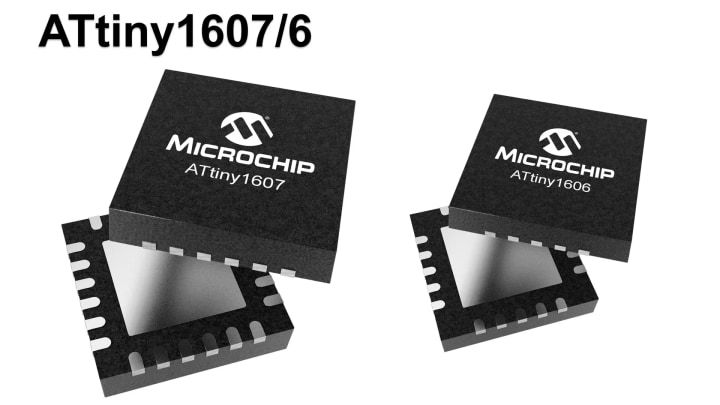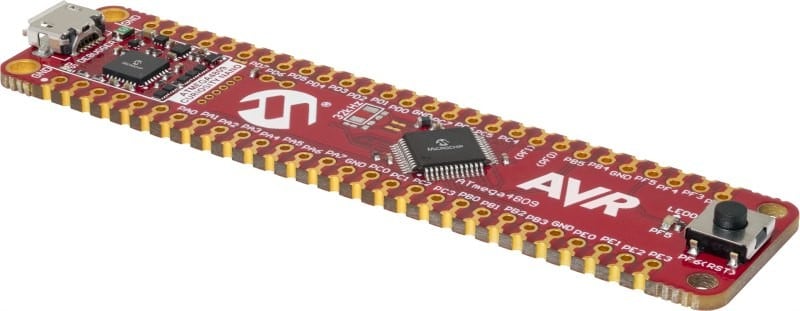Small AVR® Microcontrollers for Closed-Loop Control Systems
The ATtiny1607 family of AVR® MCUs is equipped with high-speed integrated analog, hardware-based Core Independent Peripherals (CIPs) and low-power performance for efficient, real-time control and sensor node applications in a small physical footprint to help optimize board layout. This family offers a broad range of memory, pin and package configurations, from 2 KB to 16 KB Flash memory and 8- to 24-pin packages. These tinyAVR® MCUs are well suited for a wide range of applications including industrial, consumer, appliance, automotive and Internet of Things (IoT) sensor nodes. The AVR ATtiny1627 family is well suited for designs that require sensors in harsh environments.

The ATtiny1607 Curiosity Nano Evaluation Kit is the ideal platform for rapid prototyping with tinyAVR MCUs. The USB-powered kit features an on-board programmer/debugger that seamlessly integrates with MPLAB® X and Microchip Studio Integrated Development Environments (IDEs). The small form factor makes the board ideal for breadboard soldering, or you can combine it with the Curiosity Nano Base for Click boardss™, which features multiple mikroBUS™ sockets so you can easily add sensors, actuators or communications interfaces from Mikroelektronika’s extensive selection of Click boards.
Significantly reduce your development time with Atmel START, our intuitive, web-based graphical configuration tool for embedded projects. While you navigate through the easy-to-use interface, Atmel START generates factory-validated C-code to help get your design started quickly. Get started today at start.atmel.com.
With a few clicks, Atmel START projects can be imported into Microchip Studio IDE and can be easily modified at any time.

System Features
Real Time Response
Event System
The Event System allows peripherals to communicate directly with each other without involving the Central Processing Unit (CPU) or bus resources. The Event System network is independent of the traditional data bus paths. This means that different triggers at the peripheral level can result in an event, such as a timer’s interrupts triggering an action in another peripheral. The Event System has three independent channels for direct peripheral-to-peripheral signaling. This is a deterministic signaling method and a perfect fit for real-time applications. The events are handled at the peripheral level whether the CPU is occupied handling interrupts or in sleep mode.
Safety First
CRC, WWDT, BOD, POR, VLM
You can use the built-in features that support safety-critical applications to add robustness and reliability to your design. These include the Windowed Watchdog Timer (WWDT) for system supervision, the Cyclic Redundancy Check (CRC) for scanning Flash memory, and the Event System for fault detection. Other features include a Voltage Level Monitor (VLM), a Brown-Out Detector (BOD) and Power-On Reset (POR) for monitoring the supply voltage.
Hardware Customization
Custom Logic
The Custom Logic peripheral is a programmable logic peripheral that can be connected to the device pins, events or other internal peripherals. This allows the you to eliminate logic gates for glue logic functions on the PCB. Each Lookup Table (LUT) consists of three inputs, a truth table, options synchronizer, filter and edge detector. Each LUT can generate an output that can be routed internally or available on pins. This eliminates the need for external logic and reduces BOM cost.
Integrated Analog
10-bit ADC, Analog Comparator
The on-board 10-bit, 150 ksps single-ended Analog-to-Digital Converter (ADC) features selectable internal voltage references with minimal temperature drift. Using the Event System, the on-board Analog Comparator (AC) can be connected to trigger autonomous operation in other peripherals, which is ideal for real-time control and closed-loop operations.